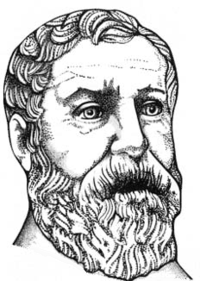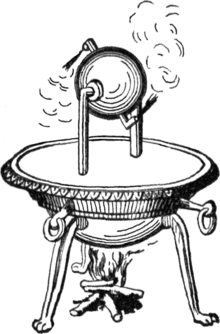Hero of Alexandria
| Hero | |
|---|---|
 | |
| Born | c. 10 AD |
| Residence | Alexandria, Roman Egypt |
| Fields | Mathematics |
| Known for | aeolipile |
Hero of Alexandria (Greek: Ἥρων ὁ Ἀλεξανδρεύς, Heron ho Alexandreus; also known as Heron of Alexandria c. 10 – c. 70 AD) was a Greek mathematician and engineer who was active in his native city of Alexandria, Roman Egypt. He is considered the greatest experimenter of antiquity[1] and his work is representative of the Hellenistic scientific tradition.[2]
Hero published a well recognized description of a steam-powered device called an aeolipile (sometimes called a "Hero engine"). Among his most famous inventions was a windwheel, constituting the earliest instance of wind harnessing on land.[3][4] He is said to have been a follower of the atomists. Some of his ideas were derived from the works of Ctesibius.
Much of Hero's original writings and designs have been lost, but some of his works were preserved in Arabic manuscripts.
Career
It is almost certain that Hero taught at the Musaeum which included the famous Library of Alexandria, because most of his writings appear as lecture notes for courses in mathematics, mechanics, physics, and pneumatics. Although the field was not formalized until the twentieth century, it is thought that the work of Hero, his automated devices in particular, represents some of the first formal research into cybernetics.[5]
Inventions

Hero described[6] the construction of the aeolipile (a version of which is known as Hero's engine) which was a rocket-like reaction engine and the first-recorded steam engine (although Vitruvius mentioned the aeolipile in De Architectura some 100 years earlier than Hero). It was created almost two millennia before the industrial revolution. Another engine used air from a closed chamber heated by an altar fire to displace water from a sealed vessel; the water was collected and its weight, pulling on a rope, opened temple doors.[7] Some historians have conflated the two inventions to assert that the aeolipile was capable of useful work.[8]

- The first vending machine was also one of his constructions, when a coin was introduced via a slot on the top of the machine, a set amount of holy water was dispensed. This was included in his list of inventions in his book, "Mechanics and Optics". When the coin was deposited, it fell upon a pan attached to a lever. The lever opened up a valve which let some water flow out. The pan continued to tilt with the weight of the coin until it fell off, at which point a counter-weight would snap the lever back up and turn off the valve.[9]
- A windwheel operating an organ, marking the first instance of wind powering a machine in history.[3][4]
- Hero also invented many mechanisms for the Greek theater, including an entirely mechanical play almost ten minutes in length, powered by a binary-like system of ropes, knots, and simple machines operated by a rotating cylindrical cogwheel. The sound of thunder was produced by the mechanically-timed dropping of metal balls onto a hidden drum.
- The force pump was widely used in the Roman world, and one application was in a fire-engine.
- A syringe-like device was described by Hero to control the delivery of air or liquids.[10]
- In optics, Hero formulated the Principle of the Shortest Path of Light: If a ray of light propagates from point A to point B within the same medium, the path-length followed is the shortest possible. It was nearly 1000 years later that Alhacen expanded the principle to both reflection and refraction, and the principle was later stated in this form by Pierre de Fermat in 1662; the most modern form is that the path is at an extremum.
- A standalone fountain that operates under self-contained hydrostatic energy. (Heron's fountain)
- A programmable cart that was powered by a falling weight. The "program" consisted of strings wrapped around the drive axle.[11]
Mathematics
Hero described a method of iteratively computing the square root.[12] Today, however, his name is most closely associated with Heron's Formula for finding the area of a triangle from its side lengths.
In media
- A 1979 Soviet animated short film focuses on Hero's invention of the aeolipile, showing him as a plain craftsman who invented the turbine accidentally[13]
- A 2007 The History Channel television show Ancient Discoveries includes recreations of most of Hero's devices
- A 2010 The History Channel television show Ancient Aliens episode "Alien Tech" includes discussion of Hero's steam engine
- A 2014 The History Channel television show Ancient Impossible episode "Ancient Einstein"
Bibliography
The most comprehensive edition of Hero's works was published in five volumes in Leipzig by the publishing house Teubner in 1903.
Works known to have been written by Hero:
- Pneumatica (Πνευματικά), a description of machines working on air, steam or water pressure, including the hydraulis or water organ[14]
- Automata, a description of machines which enable wonders in temples by mechanical or pneumatical means (e.g. automatic opening or closing of temple doors, statues that pour wine, etc.); See Automaton and Bernardino Baldi's translation[15]
- Mechanica, preserved only in Arabic, written for architects, containing means to lift heavy objects
- Metrica, a description of how to calculate surfaces and volumes of diverse objects
- On the Dioptra, a collection of methods to measure lengths, a work in which the odometer and the dioptra, an apparatus which resembles the theodolite, are described
- Belopoeica, a description of war machines
- Catoptrica, about the progression of light, reflection and the use of mirrors
Works that sometimes have been attributed to Hero, but are now thought most likely to have been written by someone else:[16]
- Geometria, a collection of equations based on the first chapter of Metrica
- Stereometrica, examples of three-dimensional calculations based on the second chapter of Metrica
- Mensurae, tools which can be used to conduct measurements based on Stereometrica and Metrica
- Cheiroballistra, about catapults
- Definitiones, containing definitions of terms for geometry
Works that are preserved only in fragments:
- Geodesia
- Geoponica
See also
References
- ↑ Research Machines plc. (2004). The Hutchinson dictionary of scientific biography. Abingdon, Oxon: Helicon Publishing. p. 546.
Hero of Alexandria (lived c. AD 60) Greek mathematician and engineer, the greatest experimentalist of antiquity
- ↑ Marie Boas, "Hero's Pneumatica: A Study of Its Transmission and Influence", Isis, Vol. 40, No. 1 (Feb., 1949), p. 38 and supra
- 1 2 A.G. Drachmann, "Heron's Windmill", Centaurus, 7 (1961), pp. 145-151
- 1 2 Dietrich Lohrmann, "Von der östlichen zur westlichen Windmühle", Archiv für Kulturgeschichte, Vol. 77, Issue 1 (1995), pp.1-30 (10f.)
- ↑ Kelly, Kevin (1994). Out of control: the new biology of machines, social systems and the economic world. Boston: Addison-Wesley. ISBN 0-201-48340-8.
- ↑ Hero (1899). "Pneumatika, Book ΙI, Chapter XI". Herons von Alexandria Druckwerke und Automatentheater (in Greek and German). Wilhelm Schmidt (translator). Leipzig: B.G. Teubner. pp. 228–232.
- ↑ Hero of Alexandria (1851). "Temple Doors opened by Fire on an Altar". Pneumatics of Hero of Alexandria. Bennet Woodcroft (trans.). London: Taylor Walton and Maberly (online edition from University of Rochester, Rochester, NY). Retrieved 2008-04-23.
- ↑ For example: Mokyr, Joel (2001). Twenty-five centuries of technological change. London: Routledge. p. 11. ISBN 0-415-26931-8.
Among the devices credited to Hero are the aeolipile, a working steam engine used to open temple doors
and Wood, Chris M.; McDonald, D. Gordon (1997). "History of propulsion devices and turbo machines". Global Warming. Cambridge, England: Cambridge University Press. p. 3. ISBN 0-521-49532-6.Two exhaust nozzles...were used to direct the steam with high velocity and rotate the sphere...By attaching ropes to the axial shaft Heron used the developed power to perform tasks such as opening temple doors
- ↑ Humphrey, John W.; John P. Oleson; Andrew N. Sherwood (1998). Greek and Roman technology: A Sourcebook. Annotated translations of Greek and Latin texts and documents. Routledge Sourcebooks for the Ancient World. London and New York: Routledge. ISBN 978-0-415-06137-7., pp.66–67
- ↑ Woodcroft, Bennet (1851). The Pneumatics of Hero of Alexandria. London: Taylor Walton and Maberly. Retrieved January 27, 2010.
No. 57. Description of a Syringe
- ↑ Noel Sharkey (July 4, 2007), A programmable robot from AD 60 2611, New Scientist
- ↑ Heath, Thomas (1921). A History of Greek Mathematics, Vol. 2. Oxford: Clarendon Press. pp. 323–324.
- ↑ animator.ru
- ↑ Jamies W. McKinnon. "Hero of Alexandria and Hydraulis". In Macy, Laura. Grove Music Online. Oxford Music Online. Oxford University Press. (subscription required)
- ↑ De gli automati, overo machine se moventi, Volume 2 (Venice, 1589; repr. 1601), On Automaton; translated from the Greek.
- ↑ O'Connor, J.J. and E.F. Robertson. "Heron biography". The MacTutor History of Mathematics archive. Retrieved 2006-06-18.
Further reading
- Drachmann, Aage Gerhardt (1963). The Mechanical Technology of Greek and Roman Antiquity: A Study of the Literary Sources. Madison, WI: University of Wisconsin Press.
- Landels, J.G. (2000). Engineering in the ancient world (2nd ed.). Berkeley: University of California Press. ISBN 0-520-22782-4.
- Marsden, E.W. (1969). Greek and Roman Artillery: Technical Treatises. Oxford: Clarendon Press.
- Schellenberg, H.M.: Anmerkungen zu Hero von Alexandria und seinem Werk über den Geschützbau, in: Schellenberg, H.M./ Hirschmann, V.E./ Krieckhaus, A.(edd.): A Roman Miscellany. Essays in Honour of Anthony R. Birley on his Seventieth Birthday, Gdansk 2008, 92-130 (with a huge bibliography of over 300 titles and discussion of the communis opinio on Hero).
External links
| Wikimedia Commons has media related to Hero of Alexandria. |
| Greek Wikisource has original text related to this article: |
- Webpage about Hero by The Technology Museum of Thessaloniki
- A translation of Pneumatica with diagrams
- Heron biography, The MacTutor History of Mathematics archive
- Hero of Alexandria in the 1911 Encyclopædia Britannica
- Hero of Alexandria in online Encyclopaedia Britannica
- Online Galleries, History of Science Collections, University of Oklahoma Libraries High resolution images preserved at The Internet Archive
-
 "Hero of Alexandria". New International Encyclopedia. 1905.
"Hero of Alexandria". New International Encyclopedia. 1905. - Reconstruction of Heron’s Formulas for Calculating the Volume of Vessels
- Spiritali di Herone Alessandrino From the John Davis Batchelder Collection at the Library of Congress
- The Pneumatics of Hero of Alexandria, from the Original Greek. Tr. and ed. by Bennet Woodcroft From the Collections at the Library of Congress
|